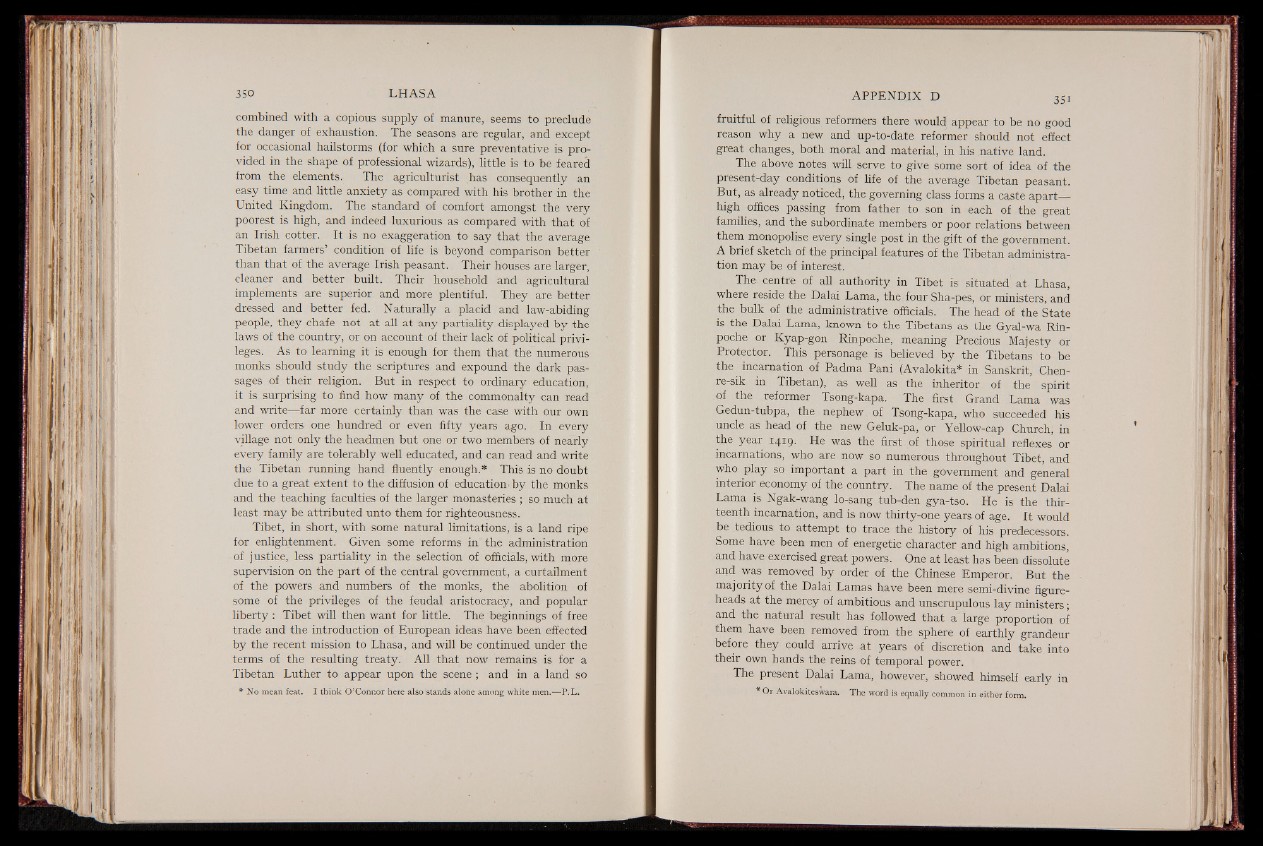
combined with a copious supply of manure, seems to preclude
the danger of exhaustion. The seasons are regular, and except
for occasional hailstorms (for which a sure preventative is provided
in the shape of professional wizards), little is to be feared
from the elements. The agriculturist ,has consequently an
easy time and little anxiety as compared with his brother in the
United Kingdom. The standard of comfort amongst the very
poorest is high, and indeed luxurious as compared with that of
an Irish cotter. It is no exaggeration to say that the average
Tibetan farmers’ condition of life is beyond comparison better
than that of the average Irish peasant. Their houses are larger,
cleaner and better built. Their household and agricultural
implements are superior and more plentiful. They are better
dressed and better fed. Naturally a placid and law-abiding
people, they chafe not at all at any partiality displayed by the
laws of the country, or on account of their lack of political privileges.
As to learning it is enough for them that the numerous
monks should study the scriptures and expound the dark passages
of their religion. But in respect to ordinary education,
it is surprising to find how many of the , commonalty can read
and write— far more certainly than was the case with our own
lower orders one hundred or even fifty years ago. In every
village not only the headmen but one or two members of nearly
every family are tolerably well educated, and can read and write
the Tibetan running hand fluently enough.* This is no doubt
due to a great extent to the diffusion of education, by the monks
and the teaching faculties of the larger monasteries ; somuch at
least may be attributed unto them for righteousness.
Tibet, in short, with some natural limitations, is a land ripe
for enlightenment. Given some reforms in'the administration
of justice, less partiality in the selection of officials, with more
supervision on the part of the central government, a curtailment
of the powers and numbers of the monks, the abolition of
some of the privileges of the feudal aristocracy, and popular
liberty : Tibet will then want for little. The beginnings of free
trade and the introduction of European ideas have been effected
by the recent mission to Lhasa, and will be continued under the
terms of the resulting treaty. All that now remains is for a
Tibetan Luther to appear upon the scene; and in a land so
* No mean feat. I think O’Connor here also stands alone among white men.— P.L.
fruitful of religious reformers there would appear to be no good
reason why a new and up-to-date reformer should not effect
great changes, both moral and material, in his native land.
The above notes will serve to give some sort of idea of the
present-day conditions of life of the average Tibetan peasant.
But, as already noticed, the governing class forms a caste apart—
high offices passing from father to son in each of the great
families, and the subordinate members or poor relations between
them monopolise every single post in the gift of the government.
A brief sketch of the principal features of the Tibetan administration
may be of interest.
The, centre of all authority in Tibet is situated at Lhasa,
where reside the Dalai Lama, theffour Sha-pes, or ministers, and
the bulk of the administrative officials. The head of the State
is the Dalai Lama, known to the Tibetans as the Gyal-wa Rin-
poche or Kyap-gon Rinpoche, meaning Precious Majesty or
Protector. This personage is believed by the Tibetans to be
the incarnation of Padma Pani (Avalokita* in Sanskrit, Chen-
re-sik in Tibetan), as well as the inheritor of the spirit
of the reformer Tsong-kapa. The first Grand Lama was
Gedun-tubpa, the nephew of Tsong-kapa, who succeeded his
uncle as head of the new Geluk-pa, or Yellow-cap Church, in
the year 1419. He was the first of those spiritual reflexes or
incarnations, who are now so numerous throughout Tibet, and
who play so important a part in the government and general
interior economy of the country. The name of the present Dalai
Lama is Ngak-wang lo-sang tub-den gya-tso. He is the thirteenth
incarnation, and is now thirty-one years of age. It would
be tedious to attempt to trace the history of his predecessors.
Some have been men of energetic character and high ambitions,
-and have exercised great powers. One at least has been dissolute
and was removed by order of the Chinese Emperor. But the
majority of the Dalai Lamas have been mere semi-divine figureheads
at the mercy of ambitious and unscrupulous lay ministers;
and the natural result has followed that a large proportion of
them have been removed from the sphere of earthly grandeur
before they could arrive at years of discretion and take into
their own hands the reins of temporal power.
The present Dalai Lama, however, showed himself early in
* Or Avalokiteswara. The word is equally common in either form.